2. 南京信息工程大学环境科学与工程学院, 江苏省大气环境检测与污染控制高技术研究重点实验室, 大气环境与装备技术协同创新中心, 南京 210044
2. Collaborative Innovation Center of Atmospheric Environment and Equipment Technology, Jiangsu Key Laboratory of Atmospheric Environment Monitoring and Pollution Control(AEMPC), School of Environmental Science and Engineering, Nanjing University of Information Science & Technology, Nanjing 210044, China
塑料因其轻便、耐用、价格低和耐腐蚀等优点而被广泛地用于生产和生活的各个方面[1].塑料制品的大量使用以及缺乏有效的回收, 导致塑料污染日益严重[2~4].近年来微塑料污染问题开始受到关注[5, 6].一般认为微塑料是粒径小于5 mm的塑料颗粒[7, 8].在水生生态系统中, 微塑料能够被生物当作食物而误食[9].由于其不能被消化而造成消化系统的损伤, 例如胃肠道阻塞和损害, 从而影响水生生物的健康和生长.同时, 由于微塑料尺寸小、比表面积大、疏水性强, 能够成为一些有毒污染物(多环芳烃、多氯联苯和重金属等)的载体[10~12].随着微塑料的摄入, 有毒物质也会进入生物体内, 导致更强的生态风险.
有研究表明微塑料已经广泛存在于水环境中[13].其来源主要包括污水处理厂出水、雨水径流和大气沉降[14~17].Sang等[14]的研究发现雨水管道径流中微塑料丰度为(2 750±760)~(19 040±2 960)n·m-3.由于累积作用城市雨水蓄水池的微塑料丰度则更高, 可达490~22 894 n·m-3[15].路面径流过程中污染物的输出与路面灰尘中污染物的干期积累密切相关[18].随着20世纪70年代开始对面源污染物问题的重视, 已经有大量研究对路面积尘中的氮、磷和重金属等一些常规污染物进行了报道[19, 20].然而对于微塑料这一新兴污染物仅有少量的研究进行了探讨[21].已经发现城市路面积尘中微塑料的来源包括汽车轮胎表面的磨损、道路涂料、建筑材料、人造草皮和破碎塑料的风力运输等[22, 23].另外, 灰尘中的粒径 < 150 μm的微塑料易被风吹起而输送到其他区域[24~26].根据Kitahara等[25]的研究, 日本东京、熊本和冲绳路面积尘中的微塑料丰度分别为(230±50)、(96±85)和(68±77)n·kg-1, 东京含量最高的原因可能是较高的人口密度和交通量.印度金奈的路面积尘中的微塑料高达(2 279.4±913.7)n·kg-1[27].而伊朗布什尔市[24]、阿萨卢耶[23]和德黑兰[28]则分别在14 800~87 600、21 000~165 800和2 766.7~20 166.7 n·kg-1的范围内变化.对比来看, 发展中国家的路面积尘中似乎比发达国家的具有更多数量的微塑料.然而这一结论还需要更多的研究数据来支撑.虽然人类活动与路面积尘中的微塑料污染程度密切相关, 但究竟是哪种具体活动的影响更为显著以及人类活动的影响是否具有区域性差异也需要厘清.
总体来看, 有关陆地系统的信息较海洋系统要相对缺乏[29, 30], 无论是进行微塑料生态风险的评估还是实施微塑料污染的管控, 都需要更多的数据作为支撑[21, 25].因此, 开展城市路面积尘微塑料的相关研究具有十分重要的理论和实践意义.本文以马鞍山市雨山区为研究对象, 分析城市路面积尘微塑料污染的空间分布特征及其与人类活动的关系, 并探讨城市路面积尘中微塑料污染的来源.
1 材料与方法 1.1 研究区域马鞍山市位于安徽省的东部、长江中下游地区.雨山区(118.44°~118.64°E、31.58°~31.74°N)现辖4个街道(雨山、安民、平湖、采石)、3个乡镇(向山、银塘、佳山)和1个省级开发区, 区域面积173 km2. 2019年春季在无风的天气情况下从雨山区采集了20个路面积尘样品, 具体位置见图 1.为了减少雨前干期的影响, 采样时期为降雨后5~7 d.采样时, 以道路中心线为界, 采集一侧路面的积尘, 采样面积根据灰尘的量确定.具体操作如下: 用普通扫帚轻轻地将积尘清扫在一起, 再使用木刷和小铁铲子将其收集, 放入干净的自封袋中密封保存[21, 23, 26].同时, 记录好采样的时间、地点和周围情况等信息.样品采集后在实验室自然风干, 以备后续分析.
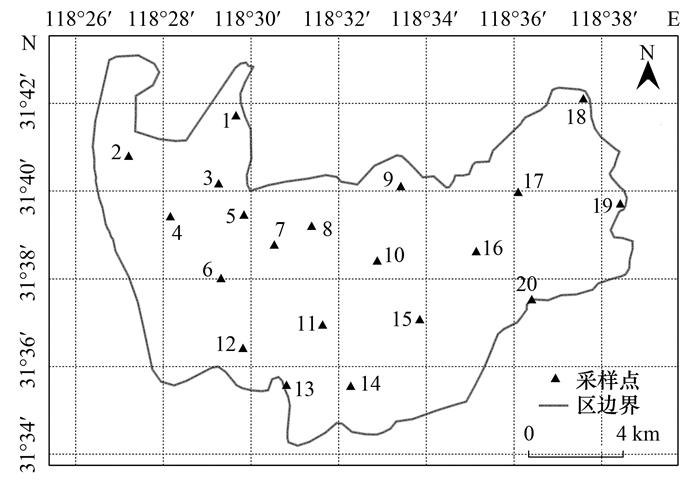
|
图 1 采样点分布示意 Fig. 1 Distribution of sampling sites |
和沉积物以及土壤相同, 一般采用密度分离方法从积尘中分离微塑料.常用的浮选液有饱和氯化钠(NaCl)溶液[31]、氯化锌(ZnCl2)溶液[32]和碘化钠(NaI)溶液[14, 22].本文选用氯化锌(ZnCl2)和氯化钠(NaCl)的混合溶液(ZnCl2 ∶NaCl ∶蒸馏水=10 ∶4.6 ∶10, ρ=1.58 g·cm-3)作为浮选液[33].将风干后的灰尘样品在60℃条件下干燥24 h.然后取200 g样品置于500 mL烧杯中, 加入400 mL浮选液, 用玻璃棒搅拌均匀后, 静置过夜.将烧杯中上清液倒入梨形分液漏斗中, 静置12 h.随后将梨形分液漏斗中的上清液过75 μm的筛子, 从底部将泥倒入烧杯继续进行浮选.微塑料浮选、过滤步骤重复3次, 以保证充分分离灰尘中的微塑料.环境中的微塑料表面会附着诸如粘土矿物和有机质等类型的物质, 可能干扰分析结果, 需要进行消解处理.常用的消解方法包括: 酸溶液消解(HNO3、HCl)、碱液消解(氢氧化钠、氢氧化钾)、氧化剂消解(过氧化氢、芬顿试剂)和酶消解.目前国内外没有统一的消解方法, 每种消解方法都存在一定的缺点. Hurley等[34]和Adomat等[35]的研究指出将一定浓度的硝酸溶液与30%双氧水联合使用是具有相对较好的消解效果且大多数聚合物不会被分解.在本研究中, 参考了王璇等[33]和周倩[36]的方法, 采用硝酸和双氧水进行消解: 将浮选过筛之后的物质经蒸馏水冲入烧杯中, 之后再加入5 mL 65%硝酸和15 mL 30%双氧水, 室温下静置8 h.消解后的溶液过0.45 μm的水系滤膜, 在烘箱温度60℃烘干后, 进行后续分析.
1.3 微塑料的表征借助放大镜和显微镜, 根据微塑料的硬度、光泽和颜色挑选出疑似微塑料后[37~39], 采用傅里叶变换红外光谱仪对其进行鉴定, 将得到的谱图与聚合物标准谱库进行对比.当匹配度超过70%时认为是微塑料[40, 41].
通过筛分得到250~500、500~1 000、1 000~2 000和2 000~5 000 μm这4个粒径范围的微塑料.借助体视显微镜对微塑料进行拍照以及塑料的颜色、形状统计.利用扫描电镜(field emission scanning electron microscopy, FE-SEM)观察微塑料的微观形貌.同时选取典型微塑料进行表面能谱(EDS)分析.
1.4 数据分析微塑料的丰度使用n·kg-1(单位质量积尘中微塑料的个数)和n·m-2(单位路面面积中微塑料的个数)表示, 含量使用mg·kg-1(单位质量积尘微塑料的含量)和mg·m-2(单位路面面积微塑料含量)表示.采用Origin 2017和Microsoft Excel 2013等软件进行绘图.利用SPSS(24.0)方差分析(ANOVA)对样本均数差别进行显著性检验.为了进一步探索积尘中微塑料的来源, 还利用SPSS软件对数据进行了聚类分析.
1.5 质量控制在采样和实验过程中, 采取了以下措施来减少外部污染: 在采样过程中, 尽可能避免使用塑料产品.实验过程中, 将所有容器用蒸馏水洗涤3次并用铝箔包裹; 实验人员均穿棉质衣服; 样品干燥过程中使用铝箔纸覆盖.空白实验使用蒸馏水过滤, 未发现微塑料.
2 结果与讨论 2.1 积尘中微塑料种类傅里叶红外光谱分析表明(图 2), 存在于路面积尘中微塑料有聚丙烯(PP)、聚乙烯(PE)、聚酯(PET)、聚苯乙烯(PS)和硅橡胶(SR).其中, 聚丙烯(58.90%)和聚乙烯(30.08%)是积尘样品中丰度最高的聚合物[图 3(a)].聚丙烯具有耐腐蚀性以及耐热性等特点, 被广泛应用于食品包装、编织袋和服装材料.聚乙烯塑料薄膜常被用于购物袋和产品外包装.二者破碎后都会成透明薄膜状微塑料.硅橡胶、聚苯乙烯和聚酯所占比例较小, 分别约为6.22%、2.80%和1.99%.聚酯类微塑料主要来源于衣物纤维.聚苯乙烯微塑料主要与商品包装以及快递运输中所用的白色泡沫有关.而硅橡胶类塑料由于其耐磨损, 耐氧化等优良性能, 主要用于汽车轮胎以及其他零部件.
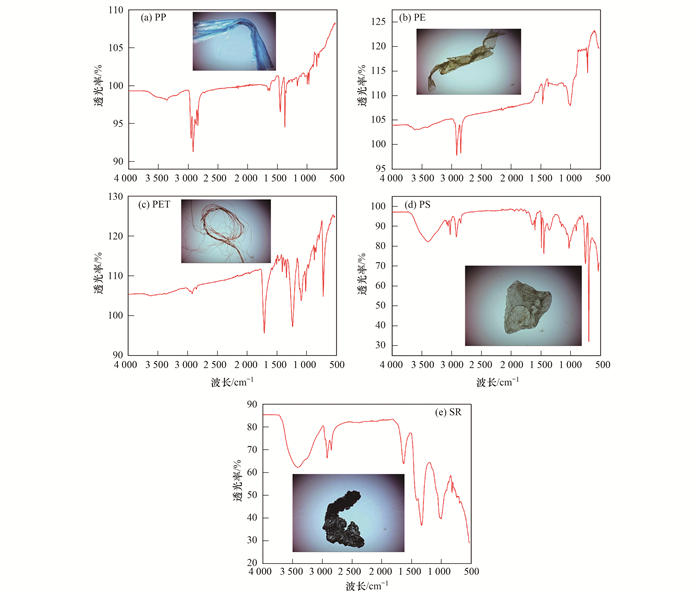
|
图 2 积尘中典型微塑料傅里叶红外光谱图 Fig. 2 Fourier infrared spectroscopy of typical MPs in road dust |

|
(a)成分; (b)粒径; (c)形状; (d)颜色 图 3 路面积尘中微塑料的物理形貌 Fig. 3 Physical morphology of microplastics in sediments |
本文利用体视显微镜和扫描电镜将路面积尘中的微塑料按照粒径、形状和颜色进行分类(图 3).积尘中微塑料粒径主要集中在250~500 μm, 数量占比约为41.75%.总体来看, 粒径小于1 000 μm的微塑料占比在65%以上.从形状来看, 研究区的微塑料可分为4类, 具体为薄膜、颗粒、纤维和球型.其中薄膜状微塑料数量最多, 占比为66.64%, 其次是颗粒状(16.14%)、纤维类(14.13%)及球型(3.10%).本研究结果与伊朗的布什尔市[24]以及阿萨卢耶[23]的情况相似, 路面积尘中的微塑料都是薄膜状为主.从颜色上来看, 研究区域的微塑料有透明色、红色、蓝色、绿色、黑色和白色这6种颜色.其中, 黑色微塑料(41.44%)居多, 其次是绿色(20.87%)和白色(13.61%).
从图 4可以看出路面积尘中的微塑料表面粗糙程度较高, 受到了不同程度的侵蚀和破坏, 具有凸起、凹陷、多孔、裂纹和缝隙等特征.主要是由于路面上的微塑料会受到人流和车流等的机械性挤压和摩擦等作用.粗糙程度较高的微塑料容易成为重金属和有机污染物等污染物的载体[42, 43].尽管使用HNO3和H2O2对微塑料进行了消解处理, 但是仍然可以看到其表面还是附着一定量的Ca、K、Fe、Al、Mn、Na、Mg和Ti等元素.而不同类型的微塑料以及在同一微塑料不同位置上的元素种类有一定的差异, 这样的结果与微塑料的种类及其表面性质和所处的环境有关.
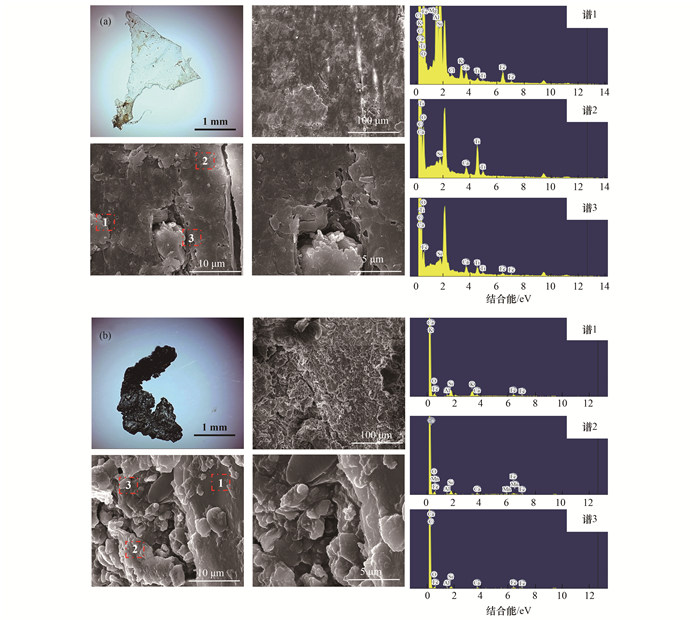
|
(a)透明薄膜; (b)黑色颗粒 图 4 积尘中微塑料场发射扫描电镜图 Fig. 4 Transmission scanning electron microscopy of MPs in road dust |
由图 5(a)~5(d)可知, 雨山区路面上的微塑料丰度为0.43~149.90 n·m-2和15.00~760.00 n·kg-1, 平均丰度为(18.11±32.36)n·m-2和(223.00±197.01)n·kg-1; 含量为0.20~329.53 mg·m-2和8.00~1 866.00 mg·kg-1, 平均含量为(27.29±72.64)mg·m-2和(385.23±628.93)mg·kg-1.以上结果表明, 微塑料普遍存在于路面积尘中. 20号点位于郊区, 单位面积路面的微塑料丰度最高, 主要是塑料垃圾缺乏有效地管理, 导致微塑料在路面积累.两一方面, 由于大货车的通行, 路面积尘负荷量大(0.45 kg·m-2), 造成单位质量积尘中的微塑料丰度较低. 9号点周边有两所学校, 人车流量大, 增加了积尘中微塑料的来源.但该采样点道路清扫频率高, 积尘负荷低(0.01 kg·m-2), 单位质量积尘中微塑料的丰度较高. 16号点的单位面积路面对应的微塑料的含量最高.该位置附近有农田和居民区, 薄膜、纤维状微塑料居多. 4、8和16号点路面积尘量较少, 单位质量积尘中微塑料含量较高.通过以上结果可以发现, 微塑料赋存情况采用不同的表达方法时, 所得到的结果可能不一致.目前不同的研究所采用的表达方法不同(表 1), 进行数据比较时, 存在一定的困难, 因此需要建立统一的表达方法.从实际应用的角度来看, 采用路面面积作为基准的表达方法可能更好一些.这种情况下可以根据单位面积丰度或含量来估算一个区域微塑料的总量.为了更好地分析路面灰尘中微塑料的丰度和含量分布与其所对应功能区之间的关系, 按照工业区、文教区、商业区、居住区和郊区5种土地利用类型微塑料污染情况进行分析[图 5(e)~5(h)].工业区、文教区、商业区、居住区和郊区对应的单位面积路面微塑料丰度分别为(10.95±5.54)、(6.99±5.74)、(78.32±101.24)、(19.81±14.30)和(8.56±8.13)n·m-2, 单位质量积尘中微塑料丰度分别为(247.50±62.92)、(425.00±473.76)、(285.00±63.64)、(326.25±200.81)和(93.13±123.52)n·kg-1, 单位面积路面微塑料含量为(19.00±19.66)、(3.12±0.27)、(2.21±2.65)、(21.84±23.20)和(46.48±114.47)mg·m-2, 单位质量积尘中微塑料含量为(628.00±793.27)、(159.00±97.58)、(10.50±2.12)、(626.26±841.89)和(293.56±606.32)mg·kg-1.商业区单位面积路面微塑料丰度相对其他区域较高, 可能是因为商业区有许多商店和餐馆, 塑料制品使用频繁, 增加了微塑料进入环境的可能性.郊区单位质量积尘微塑料的平均丰度最低, 主要是由于郊区积尘量较大.而微塑料的含量在各个区域的分布整体没有显著性差异(单位质量积尘中微塑料含量: F=0.522, P=0.721; 单位面积路面微塑料含量: F=0.229, P=0.918).
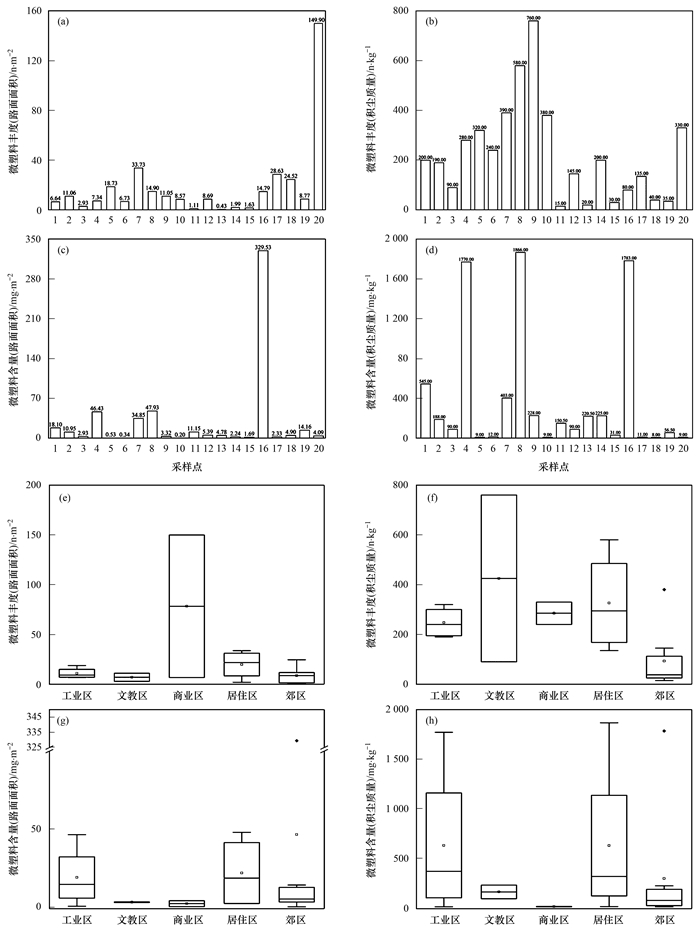
|
图 5 雨山区路面积尘微塑料空间分布 Fig. 5 Spatial distribution characteristics of MPs in road dust in Yushan District |
|
|
表 1 研究区域与文献路面积尘微塑料丰度比较 Table 1 Comparison of the microplastic abundance in road dust between the study area and the literature |
路面积尘主要来源于路面材料、土壤尘、机动车尾气尘和大气沉降[44], 是持续产生的.路面微塑料的来源包括汽车轮胎表面的磨损、道路涂料、建筑材料、人造草皮和大塑料垃圾的破碎[22, 26, 45], 这些产生过程不一定是持续的.较大的塑料进入环境之后, 经过路面车辆磨损等外力作用下破碎成许多更小的塑料, 会导致微塑料的数量增加.但是在微塑料破碎过程中其质量有可能变化不大.将微塑料丰度与积尘负荷进行相关性分析发现, 单位面积路面微塑料丰度与积尘负荷显著相关(r=0.599, P=0.005 < 0.01); 而积尘负荷和单位面积路面微塑料含量(r=0.067, P=0.780)没有显著相关性(图 6).有研究表明单位面积路面微塑料丰度高的区域, 微塑料降雨输出更多[17, 19, 20], 所以合理地清扫频率可以降低微塑料的数量.同时也可减少降雨时向水环境中输入的微塑料数量.结果还表明单位质量路面积尘微塑料丰度(r=-0.259, P=0.269)和含量(r=-0.182, P=0.442)与积尘负荷没有显著相关性.

|
图 6 积尘负荷与微塑料分布相关性 Fig. 6 Correlation between the mass of dust and distribution of MPs |
通过与其他区域的研究结果比较发现, 雨山区路面积尘微塑料的含量与部分区域处于同一污染水平[21].丰度较草津和加德满都等城市偏高[22, 25](表 1), 而相对于印度的金奈[27]以及伊朗的阿萨卢耶[23]和布什尔市[24]偏低.丰度的差异和清扫的方式、频率、降雨情况以及路面洒水等因素有关.对于草津、东京和加德满都等城市, 每天的清扫频率高, 减少了路面积尘以及微塑料的积累, 而印度和伊朗的路面清扫频率低, 人流量大, 路边塑料垃圾堆积较多, 积尘中微塑料的来源多.
2.4 城市路面积尘微塑料污染来源分析聚类分析是基于单位路面面积中微塑料丰度及其物理形貌的相似性对采样位置进行划分, 结果如图 7所示.可以看出, 20个采样点被分为3组.第一组包括11、13、14、3、9、7、4、2、8、12、15、6和10号点, 大部分点位于郊区, 路面积尘量较多, 单位路面面积中微塑料丰度较低.第二组包括5、17、19、16、18和7号点, 位于人类活动较为频繁的区域, 微塑料产生量大, 丰度较高.第三组仅包含20号点, 该点积尘量较高, 单位路面面积微塑料丰度最高.路面积尘中主要为聚丙烯和聚乙烯薄膜类微塑料.聚丙烯和聚乙烯类塑料大多应用在购物袋、食品包装、家用物品等领域.这些塑料在使用后被丢弃, 破碎成更小的碎片后沉积在路面积尘中.硅橡胶类塑料由于其耐磨损, 耐氧化等优良性能, 被广泛用于汽车轮胎、软管、鞋底和其他零部件.车辆在行驶过程中, 轮胎会磨损产生出一定量的微塑料.Wang等[46]的研究指出, 车辆轮胎或者其他橡胶产品磨碎后主要为黑色颗粒和碎片.因此路面积尘中的硅橡胶类微塑料来源于汽车轮胎的磨损.微塑料扫描电镜能谱结果中汽车尾气中微量元素的存在[27], 也证明了微塑料来源于汽车轮胎以及其他零部件的磨损.聚酯类塑料包括聚酯纤维和碎片, 聚酯纤维来源于衣物纤维, 碎片来源于饮料瓶的破碎.聚苯乙烯微塑料多为白色泡沫, 在产品包装、快递运输和外卖饭盒中使用较多, 由于其密度低, 破碎后容易迁移到路面积尘中.
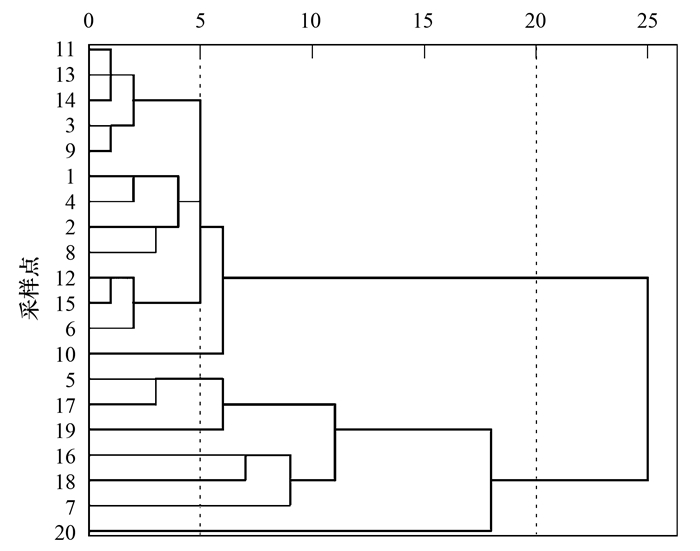
|
图 7 雨山区采样点聚类的树状图(欧式聚类) Fig. 7 Dendrogram showing clustering of sampling sites from Yushan District (Euclidean clustering) |
(1) 城市路面积尘微塑料多为透明薄膜类和黑色颗粒, 成分有聚丙烯、聚乙烯和硅橡胶类, 粒径小于1 000 μm的微塑料占据主导地位.
(2) 不同功能区的路面积尘中的微塑料丰度有一定差异.商业区由于人车流量大, 其单位面积路面微塑料丰度相对其他区域较高, 微塑料污染也更为严重.
(3) 对于微塑料污染状况采用不同表达方法时, 得出的结论可能会具有较大的差别, 急需建立统一的表达方法.
(4) 由于路面积尘和微塑料主要来源的差异, 路面积尘累积过程中微塑料的质量可以没有显著的变化.但车辆等的外力作用能使微塑料发生破碎导致其数量增加, 出现积尘负荷越高, 单位面积路面微塑料丰度也越高的情况.
| [1] | Van Cauwenberghe L, Devriese L, Galgani F, et al. Microplastics in sediments: a review of techniques, occurrence and effects[J]. Marine Environmental Research, 2015, 111: 5-17. DOI:10.1016/j.marenvres.2015.06.007 |
| [2] | Capozzi F, Carotenuto R, Giordano S, et al. Evidence on the effectiveness of mosses for biomonitoring of microplastics in fresh water environment[J]. Chemosphere, 2018, 205: 1-7. DOI:10.1016/j.chemosphere.2018.04.074 |
| [3] | Li C, Busquets R, Campos L C. Assessment of microplastics in freshwater systems: A review[J]. Science of the Total Environment, 2020, 707. DOI:10.1016/j.scitotenv.2019.135578 |
| [4] | Liu K, Wang X H, Fang T, et al. Source and potential risk assessment of suspended atmospheric microplastics in Shanghai[J]. Science of the Total Environment, 2019, 675: 462-471. DOI:10.1016/j.scitotenv.2019.04.110 |
| [5] | Pramanik B K, Roychand R, Monira S, et al. Fate of road-dust associated microplastics and per- and polyfluorinated substances in stormwater[J]. Process Safety and Environmental Protection, 2020, 144(10): 236-241. |
| [6] | Chamas A, Moon H, Zheng J J, et al. Degradation rates of plastics in the environment[J]. ACS Sustainable Chemistry & Engineering, 2020, 8(9): 3494-3511. |
| [7] | Al-Thawadi S. Microplastics and nanoplastics in aquatic environments: challenges and threats to aquatic organisms[J]. Arabian Journal for Science and Engineering, 2020, 45(6): 4419-4440. DOI:10.1007/s13369-020-04402-z |
| [8] | Stock F, Kochleus C, Bänsch-Baltruschat B, et al. Sampling techniques and preparation methods for microplastic analyses in the aquatic environment-A review[J]. TrAC Trends in Analytical Chemistry, 2019, 113: 84-92. DOI:10.1016/j.trac.2019.01.014 |
| [9] | Browne M A, Underwood A J, Chapman M G, et al. Linking effects of anthropogenic debris to ecological impacts[J]. Proceedings of the Royal Society B: Biological Sciences, 2015, 282(1807). DOI:10.1098/rspb.2014.2929 |
| [10] | Gao F L, Li J X, Sun C J, et al. Study on the capability and characteristics of heavy metals enriched on microplastics in marine environment[J]. Marine Pollution Bulletin, 2019, 144: 61-67. DOI:10.1016/j.marpolbul.2019.04.039 |
| [11] | Wang J, Li J, Wang Q, et al. Microplastics as a vector for HOC bioaccumulation in earthworm Eisenia fetida in soil: importance of chemical diffusion and particle size[J]. Environmental Science & Technology, 2020, 54(19): 12154-12163. |
| [12] | Tourinho P S, Kočí V, Loureiro S, et al. Partitioning of chemical contaminants to microplastics: sorption mechanisms, environmental distribution and effects on toxicity and bioaccumulation[J]. Environmental Pollution, 2019, 252: 1246-1256. DOI:10.1016/j.envpol.2019.06.030 |
| [13] | Niu L H, Li Y Y, Li Y, et al. New insights into the vertical distribution and microbial degradation of microplastics in urban river sediments[J]. Water Research, 2021, 188. DOI:10.1016/j.watres.2020.116449 |
| [14] | Sang W J, Chen Z Y, Mei L J, et al. The abundance and characteristics of microplastics in rainwater pipelines in Wuhan, China[J]. Science of the Total Environment, 2021, 755. DOI:10.1016/j.scitotenv.2020.142606 |
| [15] | Liu F, Olesen K B, Borregaard A R, et al. Microplastics in urban and highway stormwater retention ponds[J]. Science of the Total Environment, 2019, 671: 992-1000. DOI:10.1016/j.scitotenv.2019.03.416 |
| [16] | Roychand R, Pramanik B K. Identification of micro-plastics in Australian road dust[J]. Journal of Environmental Chemical Engineering, 2020, 8(1). DOI:10.1016/j.jece.2019.103647 |
| [17] | Shruti V C, Pérez-Guevara F, Elizalde-Martínez I, et al. Current trends and analytical methods for evaluation of microplastics in stormwater[J]. Trends in Environmental Analytical Chemistry, 2021, 30. DOI:10.1016/j.teac.2021.e00123 |
| [18] | Järlskog I, Strömvall A M, Magnusson K, et al. Occurrence of tire and bitumen wear microplastics on urban streets and in sweepsand and washwater[J]. Science of the Total Environment, 2020, 729. DOI:10.1016/j.scitotenv.2020.138950 |
| [19] | Kumari S, Jain M K, Elumalai S P. Assessment of pollution and health risks of heavy metals in particulate matter and road dust along the road network of Dhanbad, India[J]. Journal of Health and Pollution, 2021, 11(29). DOI:10.5696/2156-9614-11.29.210305 |
| [20] |
林孜, 姬亚芹, 林宇, 等. 鞍山市道路扬尘碳组分特征及来源解析[J]. 环境科学, 2020, 41(9): 3918-3923. Lin Z, Ji Y Q, Lin Y, et al. Characteristics and source apportionment of carbon components in road dust in Anshan[J]. Environmental Science, 2020, 41(9): 3918-3923. |
| [21] | Su L, Nan B X, Craig N J, et al. Temporal and spatial variations of microplastics in roadside dust from rural and urban Victoria, Australia: implications for diffuse pollution[J]. Chemosphere, 2020, 252. DOI:10.1016/j.chemosphere.2020.126567 |
| [22] | Yukioka S, Tanaka S, Nabetani Y, et al. Occurrence and characteristics of microplastics in surface road dust in Kusatsu (Japan), Da Nang (Vietnam), and Kathmandu (Nepal)[J]. Environmental Pollution, 2020, 256. DOI:10.1016/j.envpol.2019.113447 |
| [23] | Abbasi S, Keshavarzi B, Moore F, et al. Distribution and potential health impacts of microplastics and microrubbers in air and street dusts from Asaluyeh County, Iran[J]. Environmental Pollution, 2019, 244: 153-164. DOI:10.1016/j.envpol.2018.10.039 |
| [24] | Abbasi S, Keshavarzi B, Moore F, et al. Investigation of microrubbers, microplastics and heavy metals in street dust: a study in Bushehr city, Iran[J]. Environmental Earth Sciences, 2017, 76(23). DOI:10.1007/s12665-017-7137-0 |
| [25] | Kitahara K I, Nakata H. Plastic additives as tracers of microplastic sources in Japanese road dusts[J]. Science of the Total Environment, 2020, 736. DOI:10.1016/j.scitotenv.2020.139694 |
| [26] | Dris R, Gasperi J, Saad M, et al. Synthetic fibers in atmospheric fallout: a source of microplastics in the environment?[J]. Marine Pollution Bulletin, 2016, 104(1-2): 290-293. DOI:10.1016/j.marpolbul.2016.01.006 |
| [27] | Patchaiyappan A, Dowarah K, Ahmed S Z, et al. Prevalence and characteristics of microplastics present in the street dust collected from Chennai metropolitan city, India[J]. Chemosphere, 2021, 269. DOI:10.1016/j.chemosphere.2020.128757 |
| [28] | Dehghani S, Moore F, Akhbarizadeh R. Microplastic pollution in deposited urban dust, Tehran metropolis, Iran[J]. Environmental Science and Pollution Research, 2017, 24(25): 20360-20371. DOI:10.1007/s11356-017-9674-1 |
| [29] | Yu L, Zhang J D, Liu Y, et al. Distribution characteristics of microplastics in agricultural soils from the largest vegetable production base in China[J]. Science of the Total Environment, 2021, 756. DOI:10.1016/j.scitotenv.2020.143860 |
| [30] | Zhang Z Y, Mamat Z, Chen Y G. Current research and perspective of microplastics (MPs) in soils (dusts), rivers (lakes), and marine environments in China[J]. Ecotoxicology and Environmental Safety, 2020, 202. DOI:10.1016/j.ecoenv.2020.110976 |
| [31] |
赵昕, 陈浩, 贾其隆, 等. 城市河道表层水及沉积物中微塑料的污染现状与污染行为[J]. 环境科学, 2020, 41(8): 3612-3620. Zhao X, Chen H, Jia Q L, et al. Pollution status and pollution behavior of microplastic in surface water and sediment of urban rivers[J]. Environmental Science, 2020, 41(8): 3612-3620. |
| [32] |
韩丽花, 徐笠, 李巧玲, 等. 辽河流域土壤中微(中)塑料的丰度、特征及潜在来源[J]. 环境科学, 2021, 42(4): 1781-1790. Han L H, Xu L, Li Q L, et al. Levels, characteristics, and potential source of micro(meso) plastic pollution of soil in Liaohe River basin[J]. Environmental Science, 2021, 42(4): 1781-1790. |
| [33] |
王璇, 牛司平, 宋小龙, 等. 城市湖泊沉积物微塑料污染特征[J]. 环境科学, 2020, 41(7): 3240-3248. Wang X, Niu S P, Song X L, et al. Characterization of microplastic pollution of sediments from urban lakes[J]. Environmental Science, 2020, 41(7): 3240-3248. |
| [34] | Hurley R R, Lusher A L, Olsen M, et al. Validation of a method for extracting microplastics from complex, organic-rich, environmental matrices[J]. Environmental Science & Technology, 2018, 52(13): 7409-7417. |
| [35] | Adomat Y, Grischek T. Sampling and processing methods of microplastics in river sediments-A review[J]. Science of the Total Environment, 2021, 758. DOI:10.1016/j.scitotenv.2020.143691 |
| [36] | 周倩. 典型滨海潮滩及近海环境中微塑料污染特征与生态风险[D]. 北京: 中国科学院大学, 2016. |
| [37] | Fries E, Dekiff J H, Willmeyer J, et al. Identification of polymer types and additives in marine microplastic particles using pyrolysis-GC/MS and scanning electron microscopy[J]. Environmental Science: Processes & Impacts, 2013, 15(10): 1949-1956. |
| [38] | Yao P, Zhou B, Lu Y H, et al. A review of microplastics in sediments: spatial and temporal occurrences, biological effects, and analytic methods[J]. Quaternary International, 2019, 519: 274-281. DOI:10.1016/j.quaint.2019.03.028 |
| [39] | Lin L, Zuo L Z, Peng J P, et al. Occurrence and distribution of microplastics in an urban river: a case study in the Pearl River along Guangzhou City, China[J]. Science of the Total Environment, 2018, 644: 375-381. DOI:10.1016/j.scitotenv.2018.06.327 |
| [40] | Peng G Y, Xu P, Zhu B S, et al. Microplastics in freshwater river sediments in Shanghai, China: a case study of risk assessment in mega-cities[J]. Environmental Pollution, 2018, 234: 448-456. DOI:10.1016/j.envpol.2017.11.034 |
| [41] | Sun X M, Wang T, Chen B J, et al. Factors influencing the occurrence and distribution of microplastics in coastal sediments: from source to sink[J]. Journal of Hazardous Materials, 2021, 410. DOI:10.1016/j.jhazmat.2020.124982 |
| [42] |
范秀磊, 邹晔锋, 刘加强, 等. 老化前后轮胎磨损微粒与聚氯乙烯微粒对抗生素的吸附-解吸行为[J]. 环境科学, 2021, 42(4): 1901-1912. Fan X L, Zou Y F, Liu J Q, et al. Adsorption and desorption behaviors of antibiotics on TWP and PVC particles before and after aging[J]. Environmental Science, 2021, 42(4): 1901-1912. |
| [43] |
薛向东, 王星源, 梅雨晨, 等. 微塑料对水中铜离子和四环素的吸附行为[J]. 环境科学, 2020, 41(8): 3675-3683. Xue X D, Wang X Y, Mei Y C, et al. Sorption behaviors of copper ions and tetracycline on microplastics in aqueous solution[J]. Environmental Science, 2020, 41(8): 3675-3683. |
| [44] | O'Brien S, Okoffo E D, Rauert C, et al. Quantification of selected microplastics in Australian urban road dust[J]. Journal of Hazardous Materials, 2021, 416. DOI:10.1016/j.jhazmat.2021.125811 |
| [45] | Klöckner P, Reemtsma T, Eisentraut P, et al. Tire and road wear particles in road environment - Quantification and assessment of particle dynamics by Zn determination after density separation[J]. Chemosphere, 2019, 222: 714-721. DOI:10.1016/j.chemosphere.2019.01.176 |
| [46] | Wang T, Zou X Q, Li B J, et al. Preliminary study of the source apportionment and diversity of microplastics: taking floating microplastics in the South China Sea as an example[J]. Environmental Pollution, 2019, 245: 965-974. DOI:10.1016/j.envpol.2018.10.110 |
 2022, Vol. 43
2022, Vol. 43


